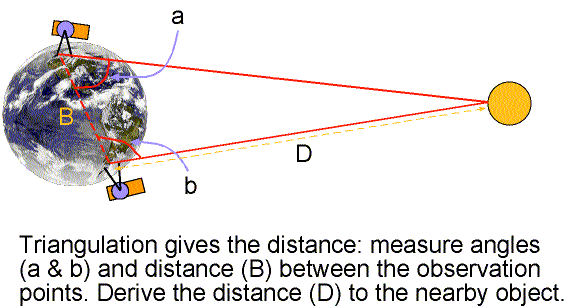
The star we call the Sun has a number of small objects circling around it. Many other stars in our Galaxy probably have objects orbiting them too and astronomers have recently discovered a few of these other systems already. The largest members of the Sun's family are called planets, and one of these we call home. That planet, Earth, has many unique characteristics that enable life to exist on it. What are the other planets like? We have learned more about our solar system in the past few decades than probably any other field of astronomy. The planets are no longer just objects up in our sky, but places we have been and explored---worlds in their own right. To give an adequate coverage of each of the planets would fill up a whole book (or more)! Since this web site is an introduction to all of astronomy, I will not explore each planet individually. Instead, I will focus on the common characteristics of the planets with special attention to their atmospheres, magnetic fields, and interiors.
Special attention will be given to the planets Venus and Mars because their orbits are similar to the Earth's orbit. Venus, Earth, and Mars were made from the same material at about the same distance from the Sun, so they should be similar to one another. However, they are radically different from one another! Venus is extremely hot with a very thick atmosphere, Mars is cold with a very thin atmosphere, and the Earth has moderate surface temperatures and a moderately-thick atmosphere that has a large amount of very reactive molecules of oxygen.
The next chapter covers the objects that give us clues of our origins: comets, meteorites, and asteroids. These objects are much smaller than planets and are made of left-over material that did not get incorporated into the planets. I will also give a brief description of what we know about how our solar system was formed in the next chapter.
This chapter covers aspects shared by all of the planets. There is a lot of high-quality information about each of the planets available on the web. Several people and organizations have put together very nice tours of the solar system with actual photos from space missions. Starting points for the best of these tours are given on the Planet Links web page. Vocabulary terms are in boldface in this chapter on planetary science.
To establish an absolute distance scale, the actual distance to one of the planets had to be measured. Distances to Venus and Mars were measured from the parallax effect by observers at different parts of the Earth when the planets were closest to the Earth.

Knowing how far apart the observers were from each other and coordinating the observation times, astronomers could determine the distance to a planet. The slight difference in its position on the sky due to observing the planet from different positions gave the planet's distance from trigonometry. The state-of-the-art measurements still had a large margin of uncertainty. The last major effort using these techniques was in the 1930's. Parallax observations of an asteroid, called Eros, passing close to Earth were used to fix the value of the astronomical unit at 150 million kilometers.
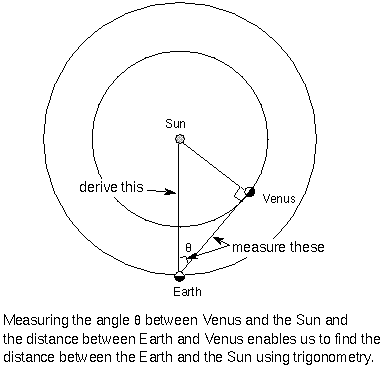
With the invention of radar, the distance to Venus could be determined very precisely. By timing how long it takes the radar beam travelling at the speed of light to travel the distance to an object and back, the distance to the object can be found from distance = (speed of light) × (total time)/2. The total time is halved to get just the distance from the Earth to the object. Using trigonometry, astronomers now know that the astronomical unit =149,597,892 kilometers. This incredible degree of accuracy is possible because the speed of light is known very precisely and very accurate clocks are used. You cannot use radar to determine the distance to the Sun directly because the Sun has no solid surface to reflect the radar efficiently.
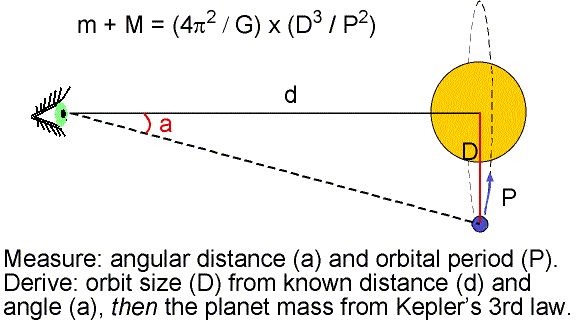
Isaac Newton used his laws of motion and gravity to generalize Kepler's third law of planet orbits to cover any case where one object orbits another. He found for any two objects orbiting each other, the sum of their masses, planet mass + moon mass = (4p2/G) × [(their distance apart)3/(their orbital period around each other)2]. Newton's form of Kepler's third law can, therefore, be used to find the combined mass of the planet and the moon from measurements of the moon's orbital period and its distance from the planet.
You can usually ignore the mass of the moon compared to the mass of the planet because the moon is so much smaller than the planet, so Kepler's third law gives you the planet's mass directly. Examples are given in the Newton's Law of Gravity chapter. For planets without moons (Mercury and Venus), you can measure their gravitational pull on other nearby planets to derive an approximate mass or for more accurate results, measure how quickly spacecraft are accelerated when they pass close to the planets.
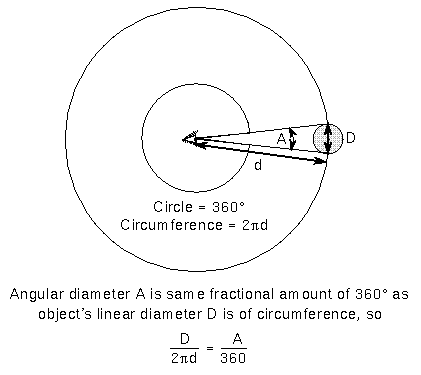
If you know how far away a planet is from you, you can determine its linear diameter D. The diameter of a planet D = 2p × (distance to the planet) × (the planet's angular size in degrees)/360ƒ, where the symbol p is a number approximately equal to 3.14 (your calculator may say 3.141592653...). The figure above explains where this formula comes from. This technique is used to find the actual diameters of other objects as well, like moons, star clusters, and even entire galaxies.
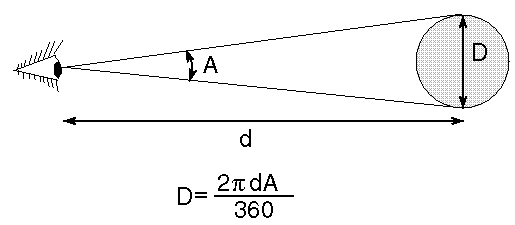
How do you do that?As the planets orbit the Sun, their distance from us changes. At ``opposition'' (when they are in the direct opposite direction from the Sun in our sky) a planet gets closest to us. These are the best times to study a planet in detail. The planet Mars reaches opposition every 780 days. Because of their elliptical orbits around the Sun, some oppositions are more favorable than others. Every 15--17 years Mars is at a favorable opposition and approaches within 55 million kilometers to the Earth. At that time its angular size across its equator is 25.5 arc seconds. In degrees this is 25.5 arc seconds × (1 degree/3600 arc seconds) = 0.00708 degrees, cancelling out arc seconds top and bottom.Its actual diameter = (2p × 55,000,000 km × 0.00708ƒ)/360ƒ = 6800 kilometers. Notice that you need to convert arc seconds to degrees to use the angular size formula. |
Little Pluto is so small and far away that its angular diameter is very hard to measure. Only a large telescope above the Earth atmosphere (like the Hubble Space Telescope) can resolve its tiny disk. However, the discovery in 1978 of a moon, called Charon, orbiting Pluto gave another way to measure Pluto's diameter. Every 124 years, the orientation of Charon's orbit as seen from the Earth is almost edge-on, so you can see it pass in front of Pluto and then behind Pluto. This favorable orientation lasts about 5 years and, fortunately for us, it occurred from 1985 to 1990.
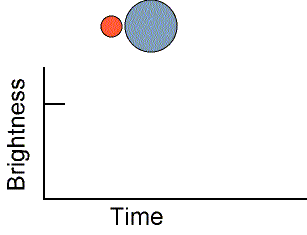
When Pluto and Charon pass in front of each other, the total light from the Pluto-Charon system decreases. The length of time it takes for the eclipse to happen and the speed that Charon orbits Pluto can be used to calculate their linear diameters. Recall that the distance travelled = speed×(time it takes). Pluto's diameter is only about 2270 kilometers (about 65% the size of our Moon!) and Charon is about 1170 kilometers across. This eclipsing technique is also used to find the diameters of the very far away stars in a later chapter. Pluto's small size and low mass (see the previous section) have some astronomers calling it an ``overgrown comet'' instead of a planet, but it is still officially considered a planet.
Another way to specify a planet's size is to use how much space it occupies, i.e., its volume. Volume is important because it and the planet's composition determine how much heat energy a planet retains after its formation billions of years ago. Also, in order to find the important characteristic of density (see the next section), you must know the planet's volume.
Planets are nearly perfect spheres. Gravity compresses the planets to the most compact shape possible, a sphere, but the rapidly-spinning ones bulge slightly at the equator. This is because the inertia of a planet's material moves it away from the planet's rotation axis and this effect is strongest at the equator where the rotation is fastest (Jupiter and Saturn have easily noticeable equatorial bulges). Since planets are nearly perfect spheres, a planet's volume can be found from volume = (p/6) × diameter3. Notice that the diameter is cubed. Even though Jupiter has ``only'' 11 times the diameter of the Earth, over 1300 Earths could fit inside Jupiter! On the other end of the scale, little Pluto has a diameter of just a little more than 1/6th the diameter of the Earth, so almost 176 Plutos could fit inside the Earth.
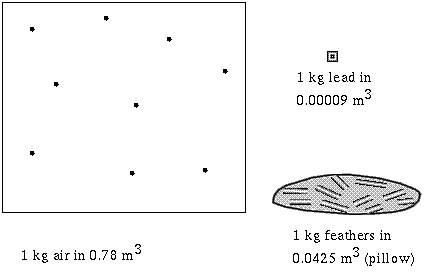
An important property of a planet that tells what a planet is made of is its density. A planet's density is how much material it has in the space the planet occupies: density = mass/volume. Planets can have a wide range of sizes and masses but planets made of the same material will have the same density regardless of their size and mass. For example, a huge, massive planet can have the same density as a small, low-mass planet if they are made of the same material. I will specify the density relative to the density of pure water because it has an easy density to rememeber: 1 gram/centimeter3 or 1000 kilograms/meter3.
The four planets closest to the Sun (Mercury, Venus, Earth, Mars) are called the terrestrial planets because they are like the Earth: small rocky worlds with relatively thin atmospheres.
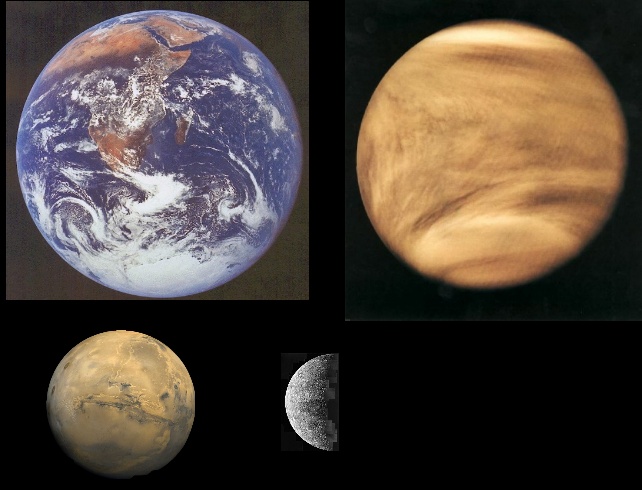
Terrestrial (Earth-like) planets have overall densities = 4-5 (relative to the density of water) with silicate rocks on the surface. Silicate rock has density = 3 (less than the average density of a terrestrial planet) and iron has a density = 7.8 (more than the average density of a terrestrial planet). Since terrestrial planets have average densities greater than that for the silicate rocks on their surface, they must have denser material under the surface to make the overall average density what it is. Iron and nickel are present in meteorites (chunks of rock left over from the formation of the solar system) and the presence of magnetic fields in some of the terrestrial planets shows that they have cores of iron and nickel. Magnetic fields can be produced by the motion of liquid iron and nickel. Putting these facts together leads to the conclusion that the terrestrial planets are made of silicate rock surrounding a iron-nickel core.
The four giant planets beyond Mars (Jupiter, Saturn, Uranus, Neptune) are called the jovian planets because they are like Jupiter: large, mostly liquid worlds with thick atmospheres.
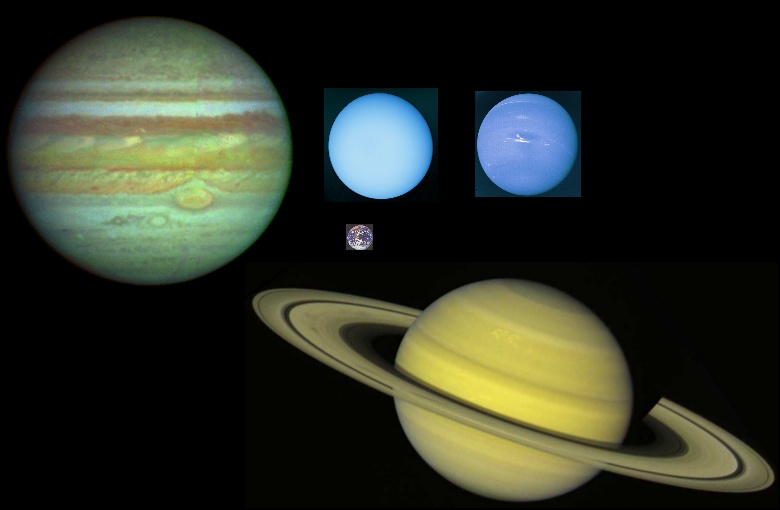
Jovian (Jupiter-like) planets have overall densities = 0.7-1.7 (relative to the density of water) with light gases visible on top. Gases and light liquids (like hydrogen and helium) have densities lower than water. Using reasoning similar to before you conclude that the jovian planets are made of gaseous and liquid hydrogen, helium and water surrounding a possible relatively small rocky core. Spectroscopy says the jovian planets have hydrogen, helium, methane, ammonia, and water gas in their thick atmospheres so the predictions are not too far off track.
The properties determined for each planet are given in the Planet Properties table. Clicking on the planet's name will bring up the full fact sheet for that planet. The important properties are given in the table.
| angular diameter | angular size | density |
|---|
The properties of each planet's atmosphere are summarized in the Planet Atmospheres and Magnetic Fields table. Two key determinates in how thick a planet's atmosphere will be are the planet's escape velocity and the temperature of the atmosphere.
Since the mass is in the top of the fraction, the escape velocity increases as the mass increases. A more massive planet will have stronger gravity and, therefore, a higher escape velocity. Also, because the distance is in the bottom of the fraction, the escape velocity decreases as the distance increases. The escape velocity is lower at greater heights above the planet's surface. The planet's gravity has a weaker hold on the molecules at the top of the atmosphere than those close to the surface, so those high up molecules will be the first to ``evaporate away.''
Do not confuse the distance from the planet's center with the planet's distance from the Sun. The escape velocity does NOT depend on how far the planet is from the Sun. You would use the Sun's distance only if you wanted to calculate the escape velocity from the Sun. In the same way, a moon's escape velocity does NOT depend on how far it is from the planet it orbits.
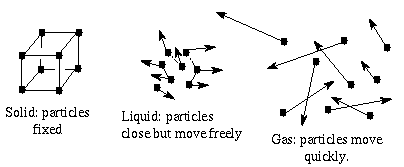
The particles in a hotter gas are moving quicker than those in a cooler gas of the same type. Using Newton's laws of motion, the relation between the speeds of the molecules and their temperature is found to be temperature = (gas molecule mass)×(average gas molecule speed)2 / (3k), where k is a universal constant of nature called the ``Boltzmann constant''. Gas molecules of the same type and at the same temperature will have a spread of speeds---some moving quickly, some moving slower---so use the average speed.
If you switch the temperature and velocity, you can derive the average gas molecule velocity = Sqrt[(3k × temperature/(molecule mass))]. Remember that the mass here is the tiny mass of the gas particle, not the planet's mass. Since the mass is in the bottom of the fraction, the more massive gas molecules will move slower on average than the lighter gas molecules. For example, carbon dioxide molecules move slower on average than hydrogen molecules at the same temperature. Because massive gas molecules move slower, planets with weaker gravity (eg., the terrestrial planets) will tend to have atmospheres made of just massive molecules. The lighter molecules like hydrogen and helium will have escaped.
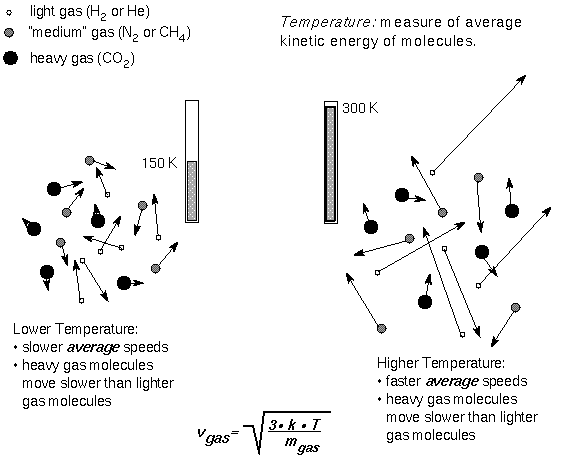
The dependence of the average speed of the gas molecules on their mass also explains the compositional structure observed in planet atmospheres. Since the distance a gas molecule can move away from the surface of a planet depends only on how fast it is moving and the planet's gravity, the lighter gas molecules can be found both close to the surface and far above it where the gravity is weaker. The gas molecules high up in the atmosphere are most likely to escape. The massive gas molecules will stay close to the planet surface. For example, the Earth's atmosphere is made of nitrogen, oxygen, and water molecules and argon atoms near the surface but at the upper-most heights, hydrogen and helium predominate.
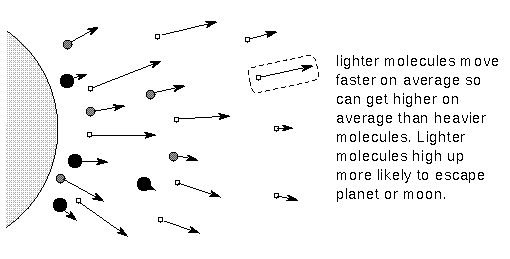

The effects of gravity and temperature work opposite to each other. A higher temperature tries to dissipate an atmosphere while higher gravity tries to retain an atmosphere. If the particle's average speed is close to the escape velocity, then those type of gas particles will not remain for billions of years. The general rule is: if the average gas molecule speed for a type of gas is less than than 0.2×(the escape velocity), then more than 1/2 of that type of gas will be left after one billion years. If the average speed is greater than that critical value, then more than 1/2 of that type of gas will be gone after one billion years. A flowchart of this is given on the escaping atmosphere page.
Because the jovian planets are massive and cold, they have THICK atmospheres of hydrogen and helium. The terrestrial planets are small in mass and warm, so they have thin atmospheres made of heavier molecules like carbon dioxide or nitrogen.
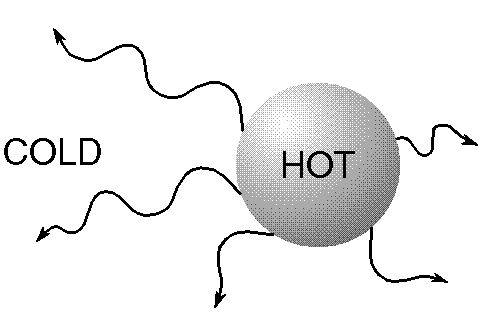
Planet atmospheres slow down the rate that heat escapes from a planet's surface or interior, as well as, distributing heat over a planet's surface. Because there is a temperature difference between the surface or interior of a planet and space, heat energy will flow from the warmer surface to the cold space. How well an atmosphere transfers heat and the methods it uses will have a profound effect on the surface temperature and weather. There are three ways gases can transfer energy:
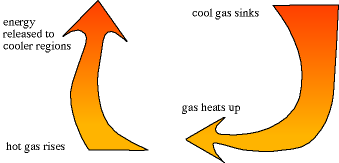
It is a sort of ``energy conveyor belt'' motion of gas. Nature will use convection only if there is a large change in temperature over a small distance (a ``steep temperature gradient''). Such conditions are found in planet atmospheres (compared to size of a planet, atmospheres are very thin!) and the interiors of stars.
In addition to transporting energy outward to space, convection also distributes the heat across the planet, from the warm daylit equatorial regions to the cooler latitudes closer to the poles and to the night side of the planet. The warm air at the equatorial regions rises and the cooler air from other parts of the planet flows across the surface toward the equator to replace the rising air. All of the winds in a planet's atmosphere are due to convective processes. If the planet is rotating quickly enough, the motion of the air can be deflected sideways by the coriolis effect.
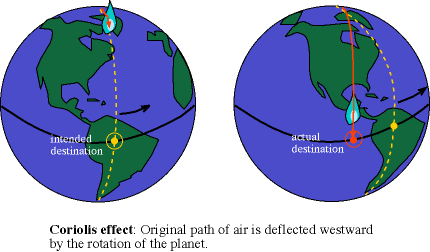
If a pocket of air from the pole moves toward the equator without changing direction, the Earth will rotate beneath it. The packet of air has a sideways motion equal to the rotation speed at the pole, but the parts of the Earth's surface closer to the equator have a greater rotational speed because they are farther from the rotation axis. To an observer on the ground, the path appears deflected to the west. The coriolis deflections produce the spiral patterns of cyclonic storms and air flow away from high-pressure regions.
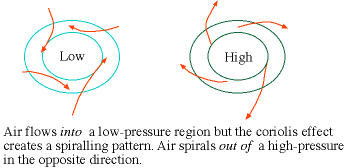
The rapid rotation of a planet will also complicate the convective flow of energy from the warm equator to the cool poles. On a planet with little or no rotation (Venus, for example), the air circulation is very simple: warm air rises along the equator, flows at high altitudes toward the poles, and near the surface returns to the equator. On a planet with rapid rotation (Earth or the jovian planets, for example), the surface winds from the poles are deflected into large-scale eddies with belts of wind and calm. At high altitudes narrow bands of high-speed winds called jet streams are formed and they play an important role on the surface weather. Land masses sticking up into the air flow disrupt the spiralling circulation and provide a place for storms to expend their energy.
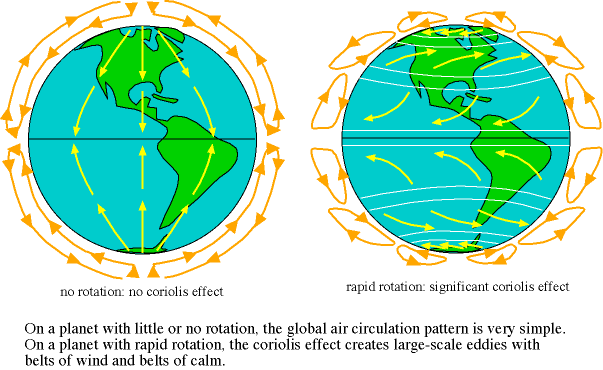
The rapidly rotating jovian planets have much greater coriolis effects. The powerful, narrow jet streams deflect the clouds into belts moving parallel to the planet equators. The winds in a belt move in the opposite direction of the belt next to it. Large vortices can from from the interplay of the belts. A large vortex can last for decades, even centuries or longer because the jovian planets do not have a solid surface for storms to expend their energy. Jupiter's Great Red Spot is an example of a large vortex. Twice the size of the Earth, it is at least 300 years old.
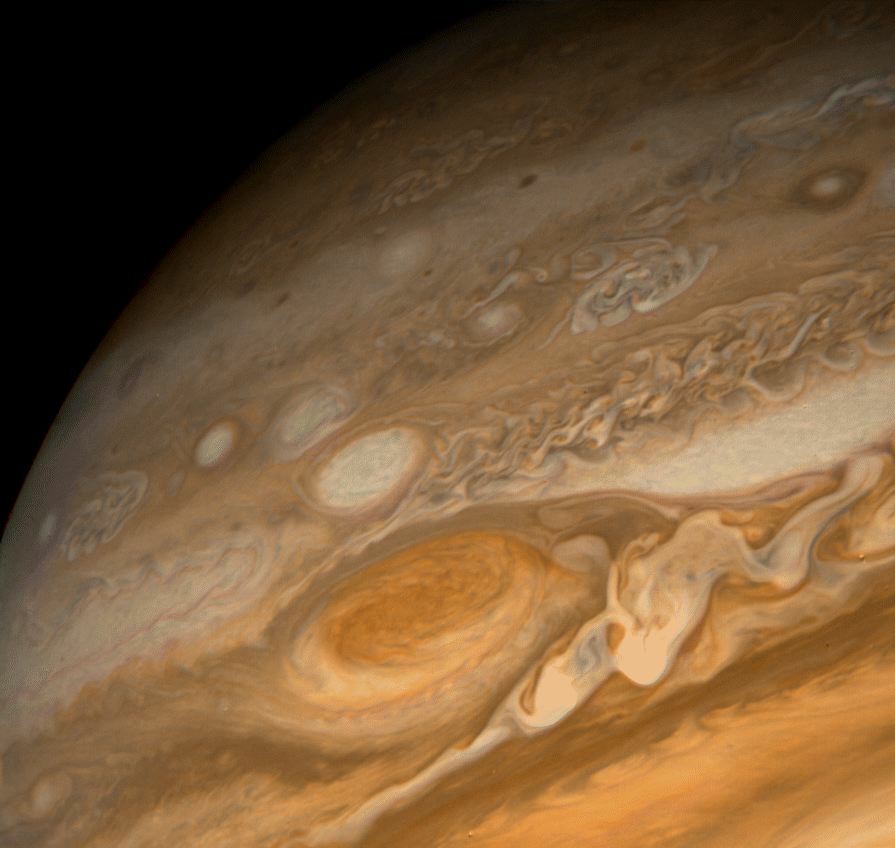
For most of the planets, the Sun provides the energy to maintain the temperature and drive the convective motions of the atmosphere. But Jupiter, Saturn, and Neptune generate over twice as much heat than they receive from the Sun. Most of this energy is left over heat from when the planets formed 4.6 billion years ago. As material collected onto the forming planets, it heated up when energy was released by the material falling in the planet's gravity field. All of the planets were hot enough to be liquid. The heavier, denser materials (like iron and nickel) separated from the lighter materials (like silicon, hydrogen, and helium) and fell toward the planet cores. The process called differentiation released more gravitational energy and heated up the planets further. Due to their large size, the jovian planets still retain a lot of their initial formation heat and that energy is responsible for the spectacular clouds patterns. In the case of Saturn, the differentiation process may still be going on as the helium in the interior separates from the hydrogen and sinks toward the core, a ``helium rain''. The helium rain is probably why there is a smaller percentage of helium in Saturn's atmosphere than in Jupiter's atmosphere.
The much blander atmosphere of Uranus is a result of its lower heat emission. Most of the heat inside the much smaller Earth and Venus is produced from radioactivity in the rocky material (in fact, the higher radioactive heating long ago may have been necessary for the terrestial planets to undergo differentiation). However, the heat of Venus' and Earth's interior has little effect on their atmospheres (though convection in their interiors is responsible for the geologic processes seen on their surfaces).
Atmospheres moderate the heat lost to space at night and shield the planet surface from energetic radiation like solar ultraviolet and X-rays and the high-speed charged particles in solar wind and cosmic rays. The planet Mercury has almost no atmosphere and so there is a difference of several hundred degrees between places in the shade and sunlit areas! The planet Mars has a very thin atmosphere, so it experiences a temperature drop of over a 100 degrees when night comes. Humans landing on the martian surface will need to contend with the extreme cold of the night and will need to protect themselves from the harmful solar radiation during the day. The Earth's atmosphere is thick enough that the temperature difference between night and day is at most a few tens of degrees. Our atmosphere also blocks high-energy light like UV and X-rays and solar wind particles. Some cosmic ray particles have high enough energy to penetrate the atmosphere and even several meters of rock! If a cosmic ray strikes the DNA in the cells, the DNA structure can be altered. Cosmic rays are responsible for some of the genetic mutations in life.
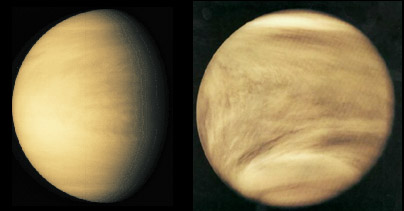
The structure of the clouds are revealed in ultraviolet light. It is the ultraviolet images that most astronomy books will use to show what Venus looks like. To see what lies below the surface, astronomers use the long wavelengths of radio. The rocky surface of Venus has been mapped using imaging radar by spacecraft orbiting Venus, such as the spectacular Magellan spacecraft that surveyed Venus in the early 1990's. Earth's atmosphere is mostly transparent to visible light with a blue tint caused by the preferential scattering of blue sunlight by the nitrogen and oxygen molecules. Clouds of water droplets and ice crystals form up to about 10 kilometers above the surface. The droplets and crystals are large enough to reflect all wavelengths of visible equally, so the clouds have a white color. Because of the coriolis effect (recall the previous section), the clouds form spiral patterns.
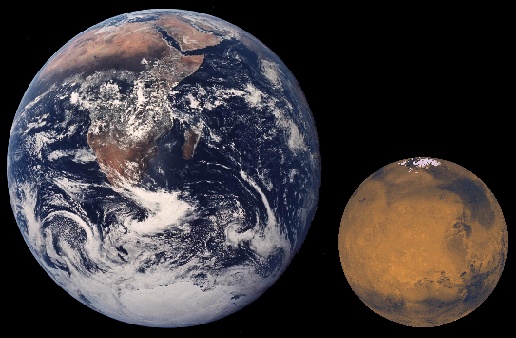
Mars' carbon dioxide atmosphere is also mostly transparent to visible light. Its thin white clouds are mostly water ice crystals. Near the poles the temperature is cold enough that carbon dioxide can freeze to form white clouds of carbon dioxide ice crystals. Some clouds have a yellow color because they are composed of fine dust particles a few micrometers across. Astronomers expected Mars' sky to have a deep blue color as seen from the surface because the atmosphere is only one percent the thickness of the Earth's atmosphere. However, pictures from the Viking and Pathfinder missions show the martian sky to be pink from sunlight bouncing off dust particles blown off Mars' red surface.
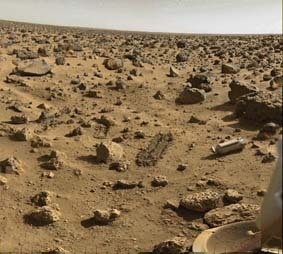 | 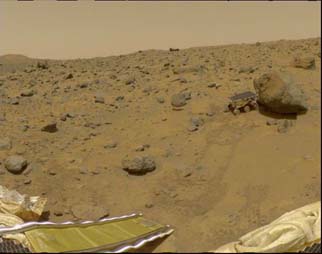 |
Jupiter's atmosphere is very dynamic and colorful and Saturn's atmosphere is a muted version of Jupiter's. Even though their atmospheres are primarily hydrogen and helium, the clouds of ammonia ice crystals in their upper atmospheres give the planets their appearance. The strong coriolis effect from their rapid rotation deflect the clouds into bands parallel to their equators.
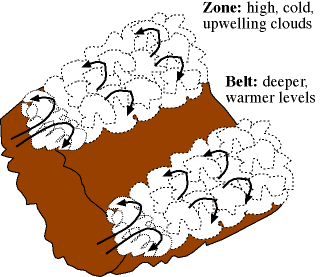
The bright zones on Jupiter are regions of upwelling convection cells in the upper atmosphere with more ammonia clouds than the darker bands. The dark bands are where we see to the warmer clouds made of ammonium hydrosulfide ice crystals about 20 to 30 kilometers below the ammonia cloud deck. Clouds of water ice crystals are thought to exist about 100 kilometers below the ammonia cloud deck, but the Galileo probe that plunged through Jupiter's clouds in early December of 1995 found no water layer. However, this may because the Galileo probe descended through an unusually dry and cloud-free part of the atmosphere.
Saturn's layer of clouds is about twice as thick as Jupiter's because of the colder temperatures and lower gravity compression on Saturn. The strong jet streams in their atmospheres create turbulent eddies of swirling clouds, some several thousands of kilometers across. One spectacular example is the Great Red Spot on Jupiter---a hurricane twice the size of the Earth that has lasted for over 300 years. Such storms and the belted patterns on the jovian planets can last so long because there is no solid surface for the storms to expend their energy.
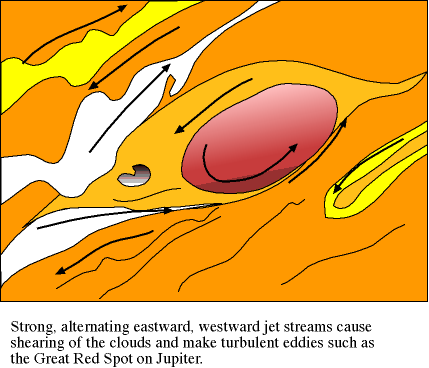 |
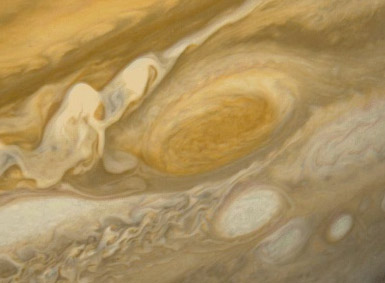 |
What is puzzling about the clouds is their color. The ammonia ice clouds should be white, yet they have a variety or red, orange, yellow, and brown colors. Sunlight striking the clouds causes photochemical reactions with the molecules in the clouds. The resulting organic compounds, or trace amounts of sulfur and phosphorus may be responsible for the colors in the clouds.
Uranus and Neptune also have thick cloud decks but Uranus' atmosphere does not have the prominent bands and storms seen on the other jovian planets. This is because Uranus does not have an extra internal heat source like the other jovian planets, so it does not have the convective motions in its atmosphere. Neptune's clouds are deflected to form bands parallel to its equator because of its rapid rotation. Neptune can also have turbulent eddies form in its atmosphere. When the Voyager spacecraft flew by Neptune in 1989, it found a large dark storm, called the Great Dark Spot (very original, yes?), that was about the size of Jupiter's Great Red Spot. However, recent Hubble Space Telescope photographs show that the Great Dark Spot seems to have dissipated.
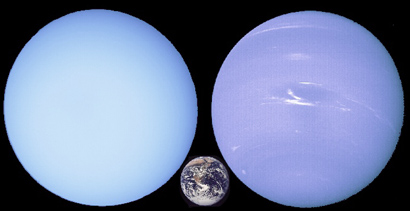
Uranus and Neptune both have a blue color. Instead of ammonia clouds, their clouds are made of frozen methane crystals because they are much colder than Jupiter and Saturn. The red and orange colors of sunlight are absorbed by the methane in their atmospheres while the blue colors are scattered back out, producing the blue color with a faint greenish tinge.
| coriolis effect | differentiation | escape velocity |
|---|---|---|
| temperature |
A planet's magnetic field forms a shield protecting the planet's surface from energetic, charged particles coming from the Sun and other places. The Sun is constantly sending out charged particles, called the solar wind, into the solar system. When solar wind particles run into a magnetic field, they are deflected and spiral around the magnetic field lines. Magnetic ``field lines'' are imaginary lines used to describe the direction charged or magnetic particles will move when responding to a magnetic field. In the same way, gravity ``field lines'' point to the center of an object producing the gravity. You can see the direction of an ordinary household magnet's field lines by sprinkling tiny iron filings around a magnetic---they will tend to bunch up along particular magnetic field lines.
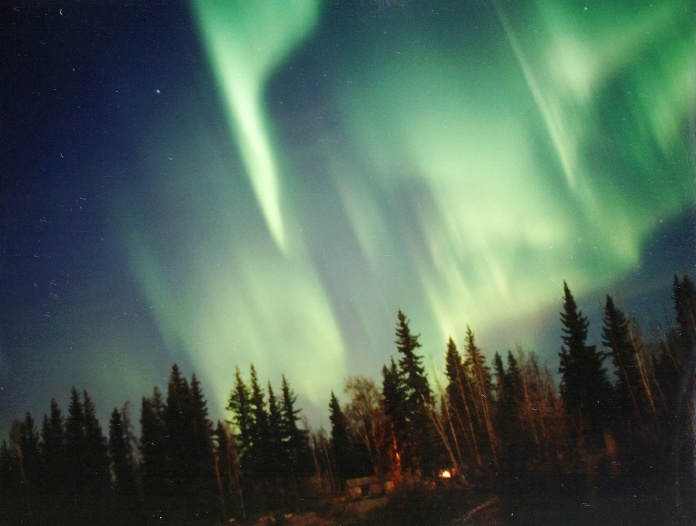
One glorious effect seen when the solar wind interacts with a planet's magnetic field is aurorae. Aurorae are shimmering light displays produced by solar wind particles deflected toward the magnetic poles and colliding with molecules in the upper atmosphere. These collisions excite the atmosphere molecules (bumping their electrons to higher energy levels). The glow of the aurorae is the emission line spectra produced by the electrons in the rarefied gas dropping back down to lower atomic energy levels.
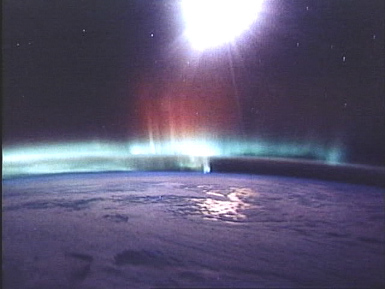
Aurorae in the Earth's atmosphere occur many tens of kilometers above the surface and pose no threat to life on the surface below. They make some spectacular displays that look like shimmering curtains or spikes of different colors of light. The red colors are produced by the hydrogen gas at the top of the atmosphere and the green colors are produced by oxygen gas below but still far above the surface. In the northern hemisphere, the aurorae are called aurora borealis or ``the northern lights'' and in the southern hemisphere, they are called aurora australis or ``the southern lights.'' The astronomy department at Rice University (Houston, TX) has a more indepth web site on the interaction of the Earth's magnetic field with the solar wind called Space Weather.
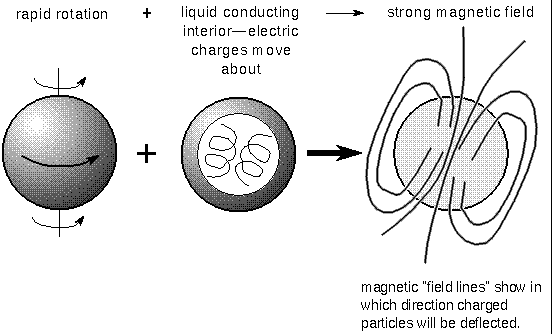
Planets do not have giant bar magnets in their cores, so what produces the magnetic field? Recall from the beginning of the Electromagnetic Radiation chapter, that a magnetic field can be produced by circulating electrical charges. A theory called the magnetic dynamo theory says that the magnetic field is produced by swirling motions of liquid conducting material in the planet interiors. Materials that can conduct electricity have some electrical charge that is free to move about. Such materials are called metallic and are not necessarily shiny solids like copper, aluminum, or iron. Jupiter and Saturn have a large amount of hydrogen that is compressed so much it forms a liquid. Some of that liquid hydrogen is in a state where some of the electrons are squeezed out of the atoms and are free to move around.
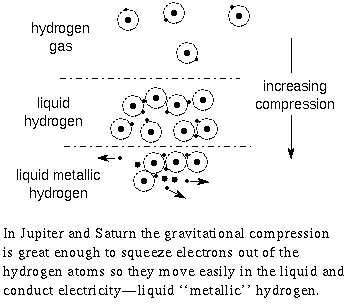
A moving charge will produce a magnetic field. The liquid conducting material in a planet's interior can be made to swirl about if the planet is rotating quickly enough. The faster a planet rotates, the more the material gets stirred up and, therefore, the stronger the generated magnetic field. If the liquid interior becomes solid or if the rotation slows down, the magnetic field will weaken. So in summary what a planet needs in order to produce a strong magnetic field is (1) a liquid conducting (metallic) interior and (2) rapid rotation to get the conducting material moving about. Let's see how this theory explains the presence or lack of a magnetic field on some of the planets:
Jupiter's magnetic field is so large that from the Earth it has an angular size over four times the size of our Moon. One of the first radio sources detected from space was from Jupiter. Solar wind particles spiralling around magnetic field lines can produce electromagnetic radiation in many different frequency bands. For Jupiter a lot of this energy is in the form of radio.
Mercury's situation is a major challenge to the magnetic dynamo theory. In true scientific fashion, the theory makes a testable prediction: Mercury should have no magnetic field or one even less than Mars' one. Observation, the final judge of scientific truth, contradicts the prediction. Should we throw out the magnetic dynamo theory then? Astronomers are reluctant to totally disregard the theory because of its success in explaining the situation on the other planets and the lack of any other plausible theory.
So most take a more conservative route: either modifying the magnetic dynamo theory or investigating Mercury more closely to find out what is so unusual about its interior to produce a magnetic field despite our expectations. Is their reluctance a violation of the objectivity required in science? Perhaps, but past experience has taught that when confronted with such a contradiction, nature is telling you that you forgot to take something into account or you overlooked a crucial process.
One example of this is the discovery of the planet Neptune. When its near twin planet, Uranus, was discovered, astronomers were very confident in Newton's gravity theory because of its over a hundred-year success rate in explaining the motions of many different types of objects. So they applied Newton's gravity theory to Uranus' orbit. However, after several decades of further observation of Uranus, the predicted orbit was significantly different from the observed orbit. Rather than throwing out Newton's gravity theory, astronomers used the contradiction to predict the presence of another planet beyond Uranus. Within a couple of years, Neptune was discovered at the position predicted! Might the same sort of thing be happening with the magnetic dynamo theory and Mercury's magnetic field? Perhaps. One thing is for sure, scientists love a good puzzle and will work hard at trying to solve it.
| aurorae | magnetic dynamo | solar wind |
|---|
last update: 09 February 1999
(661) 395-4526
Bakersfield College
Physical Science Dept.
1801 Panorama Drive
Bakersfield, CA 93305-1219